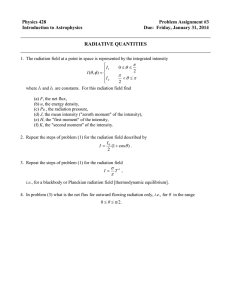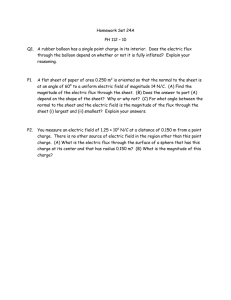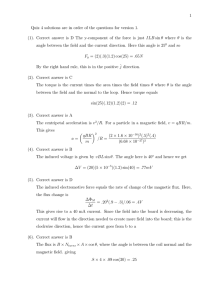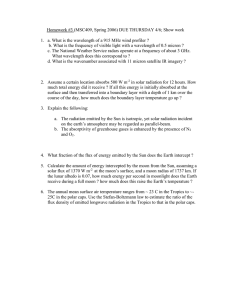ν λ π λ - Millersville Meteorology
advertisement
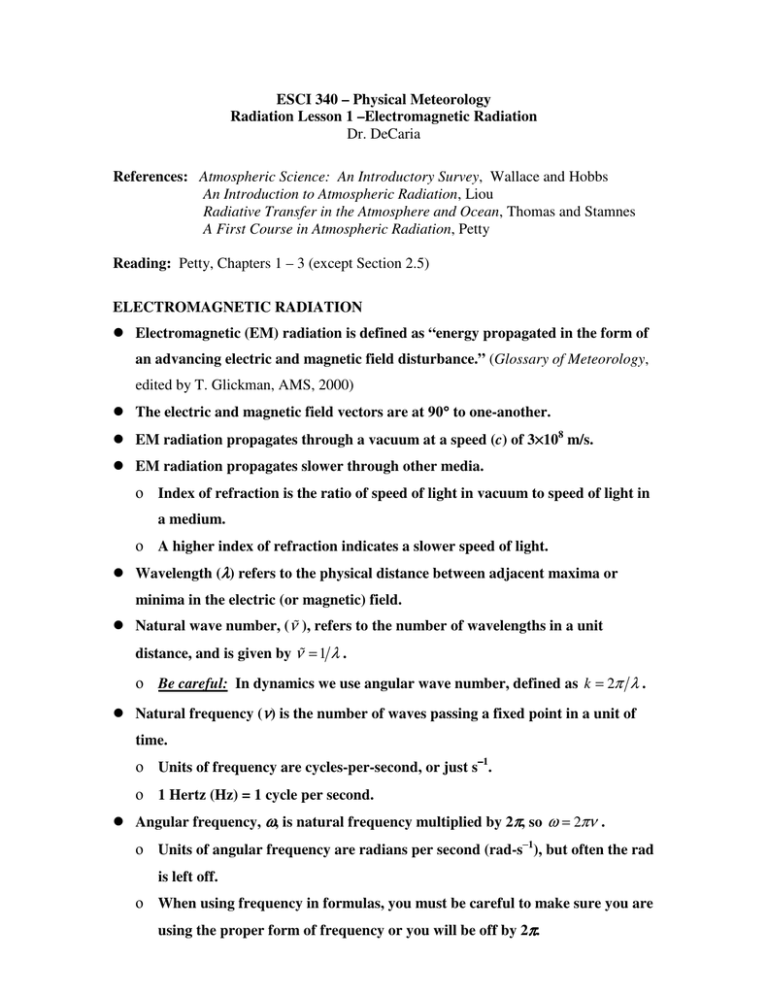
ESCI 340 – Physical Meteorology Radiation Lesson 1 –Electromagnetic Radiation Dr. DeCaria References: Atmospheric Science: An Introductory Survey, Wallace and Hobbs An Introduction to Atmospheric Radiation, Liou Radiative Transfer in the Atmosphere and Ocean, Thomas and Stamnes A First Course in Atmospheric Radiation, Petty Reading: Petty, Chapters 1 – 3 (except Section 2.5) ELECTROMAGNETIC RADIATION Electromagnetic (EM) radiation is defined as “energy propagated in the form of an advancing electric and magnetic field disturbance.” (Glossary of Meteorology, edited by T. Glickman, AMS, 2000) The electric and magnetic field vectors are at 90°° to one-another. EM radiation propagates through a vacuum at a speed (c) of 3× ×108 m/s. EM radiation propagates slower through other media. ο Index of refraction is the ratio of speed of light in vacuum to speed of light in a medium. ο A higher index of refraction indicates a slower speed of light. Wavelength (λ) refers to the physical distance between adjacent maxima or minima in the electric (or magnetic) field. Natural wave number, (ν ), refers to the number of wavelengths in a unit distance, and is given by ν = 1 λ . ο Be careful: In dynamics we use angular wave number, defined as k = 2π λ . Natural frequency (ν) is the number of waves passing a fixed point in a unit of time. ο Units of frequency are cycles-per-second, or just s−1. ο 1 Hertz (Hz) = 1 cycle per second. Angular frequency, ω, is natural frequency multiplied by 2π, so ω = 2πν . ο Units of angular frequency are radians per second (rad-s−1), but often the rad is left off. ο When using frequency in formulas, you must be careful to make sure you are using the proper form of frequency or you will be off by 2π. Frequency and wavelength are related by ν = c/λ. ο A higher frequency means a shorter wavelength. The energy associated with electromagnetic radiation is contained in discrete packets called photons. ο The energy contained in a photon is proportional to frequency, and is given by E = hν, where h is Planck’s constant (h = 6.626×10 −34 J-s). ο Higher frequency (shorter wavelength) radiation has more energetic photons. ELECTROMAGNETIC SPECTRUM The EM spectrum is classified into bands, based on frequency (or wavelength). From shortest to longest wavelengths, the bands are ο Gamma rays ο x-rays ο Ultraviolet ο Visible ο Infrared ο Microwave ο UHF ο VHF ο HF (shortwave radio) ο AM radio The visible portion of the spectrum has wavelengths of ~ 0.4 to 0.7 µm. ο The colors of the visible spectrum, from longest to shortest wavelength, are Red, Orange, Yellow, Green, Blue, Indigo, Violet (ROY G. BIV). SOLID ANGLE Solid angle is defined as the ratio of the area on a spherical surface divided by the square of the radius. ο ω = As/r 2; As is the spherical area. 2 The unit of solid angle is the steradian (sr). ο There are 4π sr in a complete sphere. In spherical coordinates, the differential area on the surface of a sphere is dAs = r 2 sin θ dθ dφ , where θ is the zenith angle, and φ is the azimuth angle. Therefore, the differential of solid angle is d ω = sin θ dθ dφ . CAUTION: There is no set convention of symbology for spherical coordinates. Many books and articles reverse the symbols and useφ for the azimuth and θ, for the zenith angle. You just have to be careful, use caution, and understand what you are doing! For very small solid angles, the area on the surface of a sphere is essentially flat. Therefore, for small solid angles, we can substitute the flat area of a disk with the spherical area with no appreciable loss of accuracy. FLUX Flux (also called flux density or irradiance) – The power crossing a unit area of surface. ο We will use the symbol F. Flux depends on the orientation of the surface. ο If the surface is oriented perpendicular to a beam of radiation the flux will be greater than if the surface is at an angle to the beam. There are two types of flux 3 ο Monochromatic flux – The flux due to a finite bandwidth of radiation. (Fλ: W m−2 µm−1) ο Total flux – The sum of the monochromatic fluxes (F: W m−2). The monochromatic and total fluxes are related via ∞ F = ∫ Fλ d λ 0 INTENSITY Intensity (also called radiance or radiant intensity) – The flux coming in from a specific direction (confined to a specific solid angle) and crossing a surface perpendicular to that specific direction. ο We will use the symbol I Intensity has a directional dependence, whereas flux does not. Intensity is a property of the radiation field only, whereas flux depends on the radiation field and on which way the surface is oriented. There are two types of intensity ο Monochromatic intensity - (Iλ: W m−2 µm−1 sr−1) ο Total intensity (I: W m−2 sr−1) Monochromatic and total intensity are related via ∞ I = ∫ Iλ d λ 0 INTENSITY VERSUS FLUX The difference between intensity and flux can be confusing. ο The key is that intensity has a directional dependence, whereas flux does not. ο I remember this using the phrase “with irr-adiance the direction is irr- elevant.” The flux is the sum of all the intensities from every possible angle (each multiplied by cos θ ), so that 2π F= 2π π 2 ∫ I cos θ dω = ∫ ∫ I cos θ sin θ dθ dφ . 0 0 0 4 The cos θ appears because we are only interested in the normal (perpendicular) component of radiation passing through the area (see diagram). The monochromatic flux can be found from the monochromatic intensity via a like expression, 2π π 2 Fλ = ∫ ∫ I λ cos θ sin θ dθ dφ . 0 0 DEPENDENCE OF FLUX ON DISTANCE FROM SOURCE The total power (P0) contained with a given solid angle (ω 0) of a beam is constant, so that P0 ω0 = Const. ο Note: If the source is isotropic, meaning the power is the same in all directions, the P0 is the total power of the source, and ω 0 is 4π sr−1. The power incident on a small, distant object that is perpendicular to the beam is P = P0 δω ω0 where δω is the solid angle that the object makes relative to the source of the beam. 5 ο Note that the power incident on the smaller object is just the total power in the beam multiplies by the ratio of the object’s solid angle to the beam’s solid angle. The flux on the object is the power incident on the object divided by the crosssectional area of the object, δA, F= P0 δω , ω0 δ A but δω δA = 1 r 2 so that F= P0 ω0 r −2 .(see Note 1) *Note 1: It may appear that this expression has the wrong units for flux, since the solid angle appears in the denominator. However, remember that a steradian actually is dimensionless (much like a radian) and so whether or not we chose to write it is meaningless. In this sense, intensity and flux have the same units (W m−2). We will always explicitly include the “per steradian (sr −1)” in the units for intensity just to avoid confusing it with flux. Thus we have that far from an isotropic source of radiation, and with no absorption or scattering of radiation, the flux decreases with the square of the distance from the source. If the surface is not perpendicular to the beam, then the flux calculated from the above formula must be modified by multiplying by cos θ where θ is the angle between the beam and a line perpendicular to the surface. Therefore, the flux on an object far from an isotropic source of radiation is F= P0 cos θ . ω0 r 2 DEPENDENCE OF INTENSITY ON DISTANCE FROM SOURCE The flux on a small distant object perpendicular to a beam of radiation was shown to be F= P0 ω0 6 r −2 . The intensity is found by dividing the flux on the object by the solid angle that the source makes with a point on the object (see Note 2). This solid angle is ωs = A r 2 where ωs is the solid angle that the source makes with the point in space at a distance r from the source, and A is the cross-sectional area of the source. The intensity is then P0 1 P0 r 2 P I= = = = 0 , 2 2 ωs ω0 r ωs ω0 r A ω0 A F which is independent of distance along the beam. Note 2: This proof only works if the object is very far from the source, so that the solid angle that the source makes with the point in space is small. A more rigorous proof that intensity is constant along a ray of radiation regardless of distance from the source is contained in “Radiative Transfer in the Atmosphere and Ocean” by Thomas and Stamnes, pp. 42-43. Thus we have that far from a uniform source of radiation, and with no absorption or scattering of radiation, the intensity is constant with distance from the source. Although the flux will decrease as an object moves farther from the source because there is less energy on the object, the solid angle that the source makes with a point in space is also decreased proportionally so that intensity remains constant along the beam. 7 EXCERCISES 1. a. Show that the solid angle that the disk of a planet makes with a satellite orbiting at a height h above the planet’s surface is 2rh + h 2 r+h ω = 2π 1 − where r is the radius of the planet. 2. What is the solid angle that the disk of the Earth makes with the center of the Sun (r = 6400 km, h = 1.5×108 km)? 3. What is the solid angle that the disk of Jupiter makes with the center of the Sun (r = 71,000 km, h = 7.8×108 km)? 4. What is the solid angle that the moon’s disk makes with the center of the Earth? The moon has a radius of 1738 km, and is about 384,400 km from the center of the Earth. 5. If radiation strikes a plane surface with the same intensity (I) regardless of the direction (this is known as isotropic radiation), show that the flux is given by F =πI . You may use an integral table to solve the integral. 6. The Sun emits radiation in all directions, yet at the top of the Earth’s atmosphere we treat the Sun’s radiation as parallel beam radiation. Why? 7. The Sun emits a total of about 3.90×1026 W of radiative power. What is the total amount of power that is intercepted (not necessarily absorbed) by the Earth? What is the total flux at the top of the Earths atmosphere (assume a distance of 1.5×108 km from the center of the sun)? 8 8. Repeat question 7 for Jupiter. 9. Show that for a narrow beam of radiation the solid angle can be given by ω ≅ π tan 2 φ 2 where φ is the angular width of the beam. 10. A 1000-Watt beam of light is spread uniformly over a narrow cone of angle 2°. a. What is the intensity of the beam? (Assume the source is a disk with a radius of 1.5 cm.) b. The beam shines onto a wall that is perpendicular to the beam, and is 3 meters away from the source. What is the flux on the illuminated portion of the wall? c. The wall is moved to a distance of 6 meters from the source. Now what is the flux on the illuminated portion of the wall? d. The wall remains at a distance of 6 meters, but is rotated so that it is now oriented at 45° to the beam. What is the flux on the wall? 9
